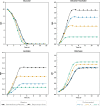Genome-scale metabolic models reveal determinants of phenotypic differences in non-Saccharomyces yeasts
- PMID: 37990145
- PMCID: PMC10664357
- DOI: 10.1186/s12859-023-05506-7
Genome-scale metabolic models reveal determinants of phenotypic differences in non-Saccharomyces yeasts
Abstract
Background: Use of alternative non-Saccharomyces yeasts in wine and beer brewing has gained more attention the recent years. This is both due to the desire to obtain a wider variety of flavours in the product and to reduce the final alcohol content. Given the metabolic differences between the yeast species, we wanted to account for some of the differences by using in silico models.
Results: We created and studied genome-scale metabolic models of five different non-Saccharomyces species using an automated processes. These were: Metschnikowia pulcherrima, Lachancea thermotolerans, Hanseniaspora osmophila, Torulaspora delbrueckii and Kluyveromyces lactis. Using the models, we predicted that M. pulcherrima, when compared to the other species, conducts more respiration and thus produces less fermentation products, a finding which agrees with experimental data. Complex I of the electron transport chain was to be present in M. pulcherrima, but absent in the others. The predicted importance of Complex I was diminished when we incorporated constraints on the amount of enzymatic protein, as this shifts the metabolism towards fermentation.
Conclusions: Our results suggest that Complex I in the electron transport chain is a key differentiator between Metschnikowia pulcherrima and the other yeasts considered. Yet, more annotations and experimental data have the potential to improve model quality in order to increase fidelity and confidence in these results. Further experiments should be conducted to confirm the in vivo effect of Complex I in M. pulcherrima and its respiratory metabolism.
Keywords: Alternative pathways; Automated reconstructions; Complex I; Electron transport chain; Enzymatic constraints; Genome-scale models; Metabolic modelling; Metschnikowia pulcherrima; Yeast; decFBA; sMOMENT.
© 2023. The Author(s).
Conflict of interest statement
The authors declare that they have no competing interests.
Figures




Similar articles
-
Impact of oxygenation on the performance of three non-Saccharomyces yeasts in co-fermentation with Saccharomyces cerevisiae.Appl Microbiol Biotechnol. 2017 Mar;101(6):2479-2491. doi: 10.1007/s00253-016-8001-y. Epub 2016 Dec 2. Appl Microbiol Biotechnol. 2017. PMID: 27913851
-
Outlining the influence of non-conventional yeasts in wine ageing over lees.Yeast. 2016 Jul;33(7):329-38. doi: 10.1002/yea.3165. Epub 2016 May 16. Yeast. 2016. PMID: 27017923
-
Yeast population dynamics reveal a potential 'collaboration' between Metschnikowia pulcherrima and Saccharomyces uvarum for the production of reduced alcohol wines during Shiraz fermentation.Appl Microbiol Biotechnol. 2015 Feb;99(4):1885-95. doi: 10.1007/s00253-014-6193-6. Epub 2014 Nov 12. Appl Microbiol Biotechnol. 2015. PMID: 25388943
-
The Life of Saccharomyces and Non-Saccharomyces Yeasts in Drinking Wine.Microorganisms. 2023 Apr 30;11(5):1178. doi: 10.3390/microorganisms11051178. Microorganisms. 2023. PMID: 37317152 Free PMC article. Review.
-
Influence of Non-Saccharomyces on Wine Chemistry: A Focus on Aroma-Related Compounds.Molecules. 2021 Jan 26;26(3):644. doi: 10.3390/molecules26030644. Molecules. 2021. PMID: 33530641 Free PMC article. Review.
Cited by
-
Metabolic modelling uncovers the complex interplay between fungal probiotics, poultry microbiomes, and diet.Microbiome. 2024 Dec 20;12(1):267. doi: 10.1186/s40168-024-01970-2. Microbiome. 2024. PMID: 39707513 Free PMC article.
-
COmmunity and Single Microbe Optimisation System (COSMOS).NPJ Syst Biol Appl. 2025 May 21;11(1):51. doi: 10.1038/s41540-025-00534-w. NPJ Syst Biol Appl. 2025. PMID: 40399328 Free PMC article.
-
Genome-Scale Metabolic Models in Fungal Pathogens: Past, Present, and Future.Int J Mol Sci. 2024 Oct 9;25(19):10852. doi: 10.3390/ijms251910852. Int J Mol Sci. 2024. PMID: 39409179 Free PMC article. Review.
-
Comparison between Metschnikowia pulcherrima and Torulaspora delbrueckii used in sequential wine fermentations with Saccharomyces cerevisiae.Front Microbiol. 2025 Jul 2;16:1590561. doi: 10.3389/fmicb.2025.1590561. eCollection 2025. Front Microbiol. 2025. PMID: 40673155 Free PMC article.
References
-
- Lin X, Tang X, Han X, He X, Han N, Ding Y, Sun Y. Effect of Metschnikowia pulcherrima on saccharomyces cerevisiae pdh by-pass in mixedfermentation with varied sugar concentrations of synthetic grape juice and inoculation ratios. Fermentation. 2022;8(10):66. doi: 10.3390/fermentation8100480. - DOI
-
- Contreras A, Curtin C, Varela C. Yeast population dynamics reveal a potential ‘collaboration’ between metschnikowia pulcherrima and saccharomyces uvarum for the production of reduced alcohol wines during shiraz fermentation. Appl Microbiol Biotechnol. 2015;99(4):1885–1895. doi: 10.1007/s00253-014-6193-6. - DOI - PubMed
-
- García M, Esteve-Zarzoso B, Cabellos JM, Arroyo T. Sequential non-saccharomyces and saccharomyces cerevisiae fermentations to reduce the alcohol content in wine. Fermentation. 2020 doi: 10.3390/fermentation6020060. - DOI
MeSH terms
Supplementary concepts
Grants and funding
LinkOut - more resources
Full Text Sources

